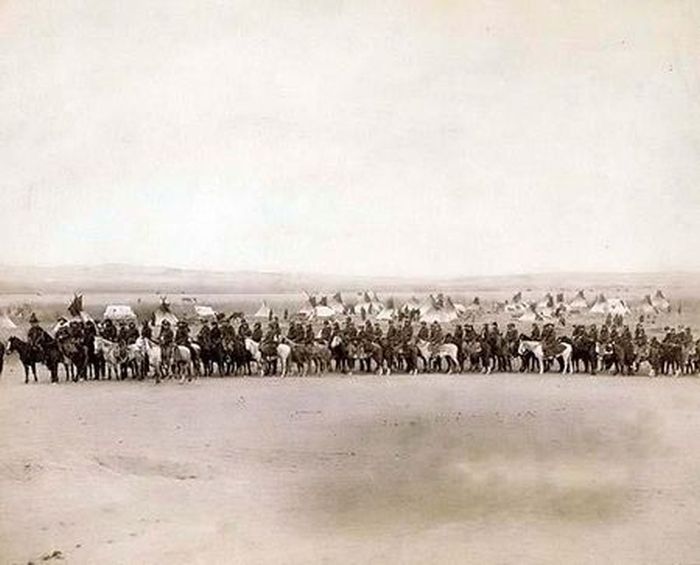History: American Old West, United States
|
The rise of the cattle industry and the cowboy is directly tied to the demise of the huge bison herds of the Great Plains. Once numbering over 25 million, bison were a vital resource animal for the Plains Indians, providing food, hides for clothing and shelter, and bones for implements. Loss of habitat, disease, and over-hunting steadily reduced the herds through the 19th century to the point of near extinction. Overland trails and growing settlements began to block the free movement of the herds to feeding and breeding areas. Initially, commercial hunters sought bison to make "pemmican", a mixture of pounded buffalo meat, fat, and berries, which was a long-lasting food used by trappers and other outdoorsmen. Not only did white hunters impact the herds, but Indians who arrived from the East also contributed to their reduction. Adding to the kill was the wanton slaughter of bison by sportsmen, migrants, and soldiers. Shooting bison from passing trains was common sport. However, the greatest negative effect on the herds was the huge markets opened up by the completion of the transcontinental railroad. Hides in great quantities were tanned into leather and fashioned into clothing and furniture. Killing far exceeded market requirements, reaching over one million per year. As many as five bison were killed for each one that reached market, and most of the meat was left to rot on the plains and at trackside after removal of the hides. Skulls were often ground for fertilizer. A skilled hunter could kill over 100 bison in a day.
By the 1870s, the great slaughter of bison had a major impact on the Plains Indians, dependent on the animal both economically and spiritually. Soldiers of the U.S. Army deliberately encouraged and abetted the killing of bison as part of the campaigns against the Sioux and Pawnee, in an effort to deprive them of their resource animal and to demoralize them.
The sharp decline of the herds of the Plains created a vacuum which was exploited by the growing cattle industry. Spanish cattlemen had introduced cattle ranching and longhorn cattle to the Southwest in the 17th century, and the men who worked the ranches, called "vaqueros", were the first "cowboys" in the West. After the Civil War―with railheads available at Abilene, Kansas City, Dodge City, and Wichita―Texas ranchers raised large herds of longhorn cattle and drove them north along the Western, Chisholm, and Shawnee trails. The cattle were slaughtered in Chicago, St. Louis, and Kansas City. The Chisholm Trail, laid out by cattleman Joseph McCoy along an old trail marked by Jesse Chisholm, was the major artery of cattle commerce, carrying over 1.5 million head of cattle between 1867 and 1871 over the 800 miles (1,300 km) from south Texas to Abilene, Kansas. The long drives were treacherous, especially crossing water such as the Brazos and the Red River and when they had to fend off Indians and rustlers looking to make off with their cattle. A typical drive would take three to four months and contained two miles (3 km) of cattle six abreast. Despite the risks, the long Texas drives proved very profitable and attracted investors from the United States and abroad. The price of one head of cattle raised in Texas was about $4 but was worth more than $40 back East.
By the 1870s and 1880s, cattle ranches expanded further north into new grazing grounds and replaced the bison herds in Wyoming, Montana, Colorado, Nebraska and the Dakota territory, using the rails to ship to both coasts. Many of the largest ranches were owned by Scottish and English financiers. The single largest cattle ranch in the entire West was owned by American John W. Iliff, "cattle king of the Plains", operating in Colorado and Wyoming. Gradually, longhorns were replaced by the American breeds of Hereford and Angus, introduced by settlers from the Northwest. Though less hardy and more disease-prone, these breeds produced better tasting beef and matured faster.
|
|









